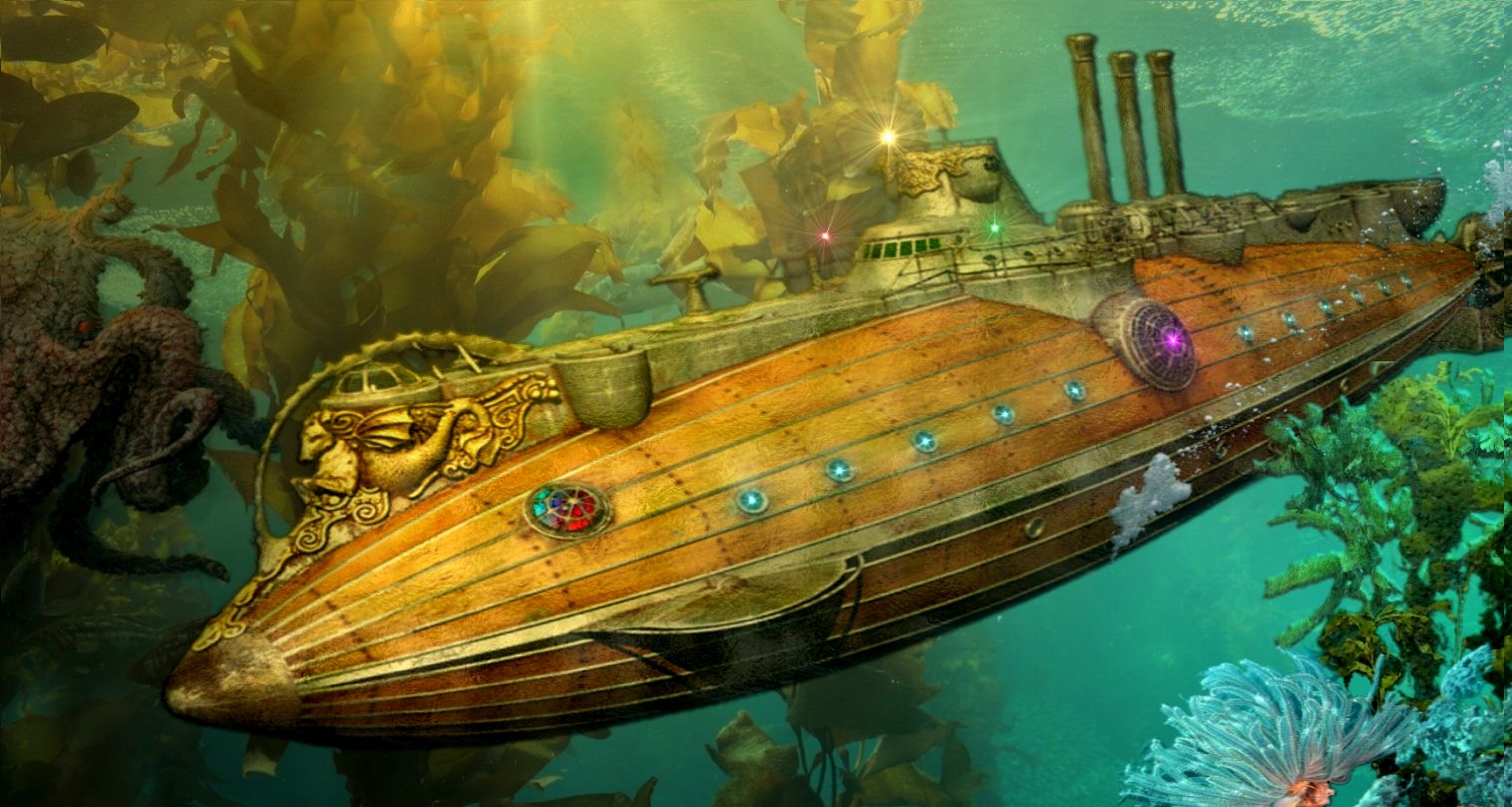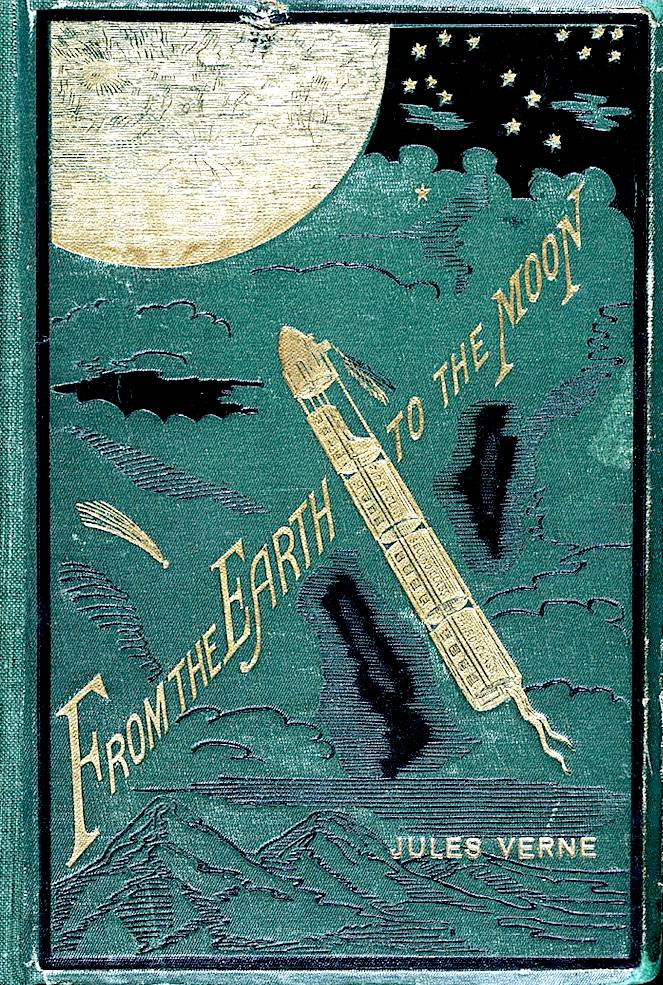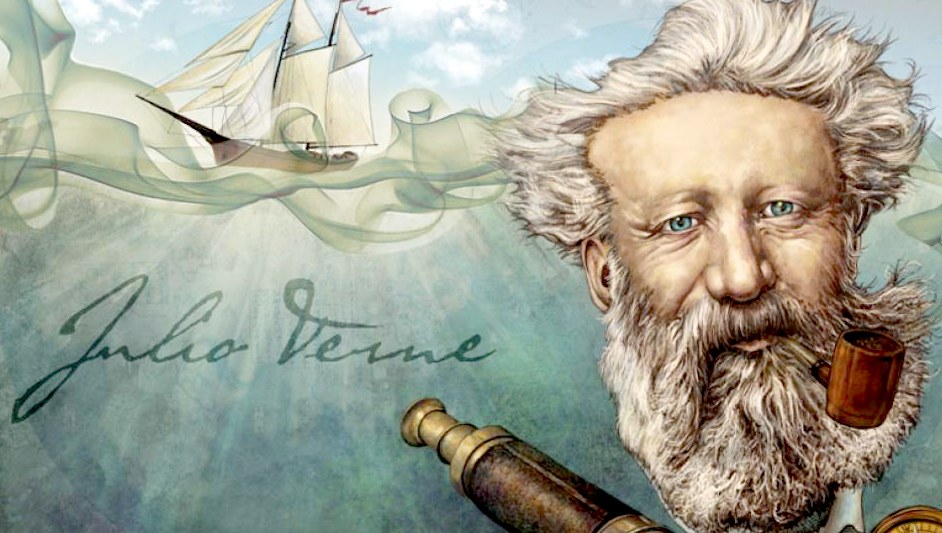|

Jules Verne has always been considered as an author ahead of the times and this book in particular shows you exactly why. Even though the book may at times seem implausible the fact remains that Verne did manage to get some of the information right from the overall cost of such a trip to some of the effects that a traveler may face when traveling to the moon. This is Verne at his creative best and one of the reasons why so many of his novels are still ranked among the top 10 of Jules Verne books.
Best
known for '20,000
Leagues Under the Sea' and Around
The World In Eighty Days, Jules Verne also authored a number of
other popular novels, that made it onto the big screen, such as 'The
Mysterious Island,' and 'Journey To The Centre Of The World.'
From
the earth to the moon. Jules Verne has always been considered as an author ahead of the times and this book in particular shows you exactly why. Even though the book may at times seem implausible the fact remains that Verne did manage to get some of the information right from the overall cost of such a trip to some of the effects that a traveler may face when traveling to the moon. This is Verne at his creative best and one of the reasons why so many of his novels are still ranked
so highly.
PLOT
The story opens some time after the end of the American Civil War. The Baltimore Gun Club, a society dedicated to the design of weapons of all kinds (especially cannons), comes together when Impey Barbicane, its president, calls them to support his latest idea. He's done some calculations, and believes that they could construct a cannon capable of shooting a projectile to the Moon. After receiving the support of his companions, another meeting is held to decide the place from which the projectile will be fired, the dimensions and materials of both the cannon and the projectile, and which kind of powder they are to use.
An old enemy of Barbicane, a Captain Nicholl of Philadelphia, designer of plate armor, declares that the entire enterprise is absurd and makes a series of bets with Barbicane, each of them of increasing amount, over the impossibility of such feat.
The first obstacle, the money to construct the giant cannon (and against which Nicholl has bet 1,000 dollars), is raised from a number of countries in America and Europe. Notably, the U.S. gives four million dollars, while England,at first, does not give a farthing, but in the end, nearly five and a half million dollars are raised, which ensures the financial feasibility of the project.
Stone's Hill in "Tampa Town", Florida is chosen as the site for the cannon's construction. The Gun Club travels there and starts the construction of the Columbiad cannon, which requires the excavation of a 900-foot-deep (270 m) and 60-foot-wide (18 m) circular hole, which is made in the nick of time, but a surprise awaits Barbicane: Michel Ardan, a French adventurer, plans to travel aboard the projectile.
During a meeting between Ardan, the Gun Club, and the inhabitants of Florida, Nicholl appears and challenges Barbicane to a duel. The duel is stopped when Ardan
- having been warned by J. T. Maston, secretary of the Gun Club - meets the rivals in the forest where they have agreed to duel. Meanwhile, Barbicane finds the solution to the problem of surviving the incredible acceleration that the explosion would cause. Ardan suggests that Barbicane and Nicholl travel with him in the projectile, and the proposition is accepted.
In the end, the projectile is successfully launched, but the destinies of the three astronauts are left inconclusive. The sequel, Around the Moon, deals with what happens to the three men in their travel from the Earth to the Moon.
IN
POPULAR CULTURE
The novel was adapted as the opera Le voyage dans la lune in 1875, with music by Jacques Offenbach.
In 1880 The Pall Mall Gazette described Verne’s Columbiad as a ‘space-ship’ - the first recorded use of this term in history.
In H. G.
Wells' 1901 novel The First Men in the Moon (also relating to the first voyagers to the Moon) the protagonist, Mr. Bedford, mentions Verne's novel to his companion, Professor Cavor, who replies (in a possible dig at Verne) that he does not know what Bedford is referring to. Verne returned the dig later when he pointed out that he used gun cotton to send his men to the Moon, an actual substance. "Can Mr. Wells show me some 'cavourite'?", he asked archly.
The novel (along with Wells' The First Men in the Moon) inspired the first science fiction film, A Trip to the Moon, made in 1902 by Georges Méliès. In 1958, another film adaptation of this story was released, titled From the Earth to the Moon. It was one of the last films made under the RKO Pictures banner. The story also became the basis for the very loose adaptation Jules Verne's Rocket to the Moon (1967), a caper-style British comedy starring Burl Ives and Terry-Thomas. The 1961 Czechoslovak film The Fabulous Baron Munchausen combines characters and plot elements from the Verne novel with those of the stories of Baron Munchausen and Cyrano de Bergerac.
In 1889 Verne wrote a second sequel to the novel, The Purchase of the North Pole, which has the Gun Club members (led by J. T. Maston) plan to use the Columbiad to alter the tilt of the Earth to enable the mineral wealth of the Arctic region to be put within reach of exploitation.
In March 1953, the Gilberton Company published a comic-book adaptation of From the Earth to the Moon as issue No. 105 in its Classics Illustrated series. An unidentified scriptwriter combined Verne's From the Earth to the Moon with the sequel, Around the Moon. Gilberton art director Alex A. Blum supplied both the cover painting and the 44 pages of interior art. The title went through twelve printings between 1953 and 1971.
During their return journey from the Moon, the crew of Apollo 11 made reference to Jules Verne's book during a TV broadcast on 23 July. The mission's commander, astronaut Neil Armstrong, said, "A hundred years ago, Jules Verne wrote a book about a voyage to the Moon. His spaceship, Columbia [sic], took off from Florida and landed in the Pacific Ocean after completing a trip to the Moon. It seems appropriate to us to share with you some of the reflections of the crew as the modern-day Columbia completes its rendezvous with the planet Earth and the same Pacific Ocean tomorrow."
In Back to the Future Part III, Clara Clayton in 1885 asks Emmett Brown if he believes mankind will ever "travel to the Moon the way we travel across the country on trains." Being from the future, Brown already knows that doesn't happen for another 84 years, but he affirms they will while inadvertently quoting a passage of From the Earth to the Moon. Clara calls him out on this, and it's from this encounter that the pair discovers their mutual love of Jules Verne novels.

From the Earth to the Moon: A Direct Route in 97 Hours, 20 Minutes (French: De la Terre à la Lune, trajet direct en 97 heures 20 minutes) is an 1865 novel by Jules Verne. It tells the story of the Baltimore Gun Club, a post-American Civil War society of weapons enthusiasts, and their attempts to build an enormous Columbiad space gun and launch three people—the Gun Club's president, his Philadelphian armor-making rival, and a French poet—in a projectile with the goal of a Moon landing. Five years later, Verne wrote a sequel called Around the Moon.
The story is also notable in that Verne attempted to do some rough calculations as to the requirements for the cannon and in that, considering the comparative lack of empirical data on the subject at the time, some of his figures are remarkably accurate. However, his scenario turned out to be impractical for safe manned space travel since a much longer barrel would have been required to reach escape velocity while limiting acceleration to survivable limits for the passengers.
The character of Michel Ardan, the French member of the party in the novel, was inspired by the real-life photographer Félix Nadar.
Jules
Verne was the author of many adventure stories:
1
Twenty Thousand Leagues Under the Sea
2 Around the World in Eighty Days
3 Journey to the Center of the Earth
4 The Mysterious Island (Extraordinary Voyages #12)
5 From the Earth to the Moon
6 Michael Strogoff (Extraordinary Voyages, #14)
7 In Search of the
Castaways; or the Children of Captain Grant (Extraordinary Voyages, #5)
8 Five Weeks in a Balloon
9
Round the Moon (Extraordinary Voyages, #7)
10 Adrift in the
Pacific: Two Years Holiday (Extraordinary Voyages, #32)
11 The Master of the World (Extraordinary Voyages, #53)
12 The Adventures of Captain Hatteras
13 Les Tribulations d'un Chinois en Chine;
The Tribulations of a Chinese in China (Extraordinary Voyages, #19)
14 The Lighthouse at the End of the World
15 Mathias Sandorf (Extraordinary Voyages, #27)
16 Off On A Comet (Extraordinary Voyages, #15)
17 Los quinientos millones de la Begún (The five hundred million of the
Begún)
18 Facing the Flag (Extraordinary Voyages, #42)
19 Un capitán de quince años (A fifteen year old captain)
20 El Testamento de un excentrico (The Testament of an eccentric)

Jules
Verne is also known as the Father of Science Fiction
|


